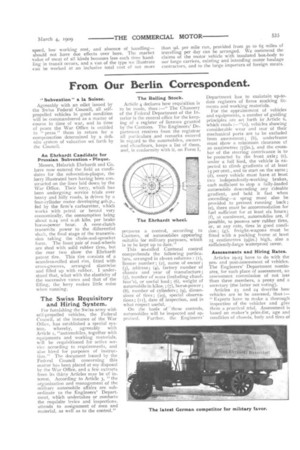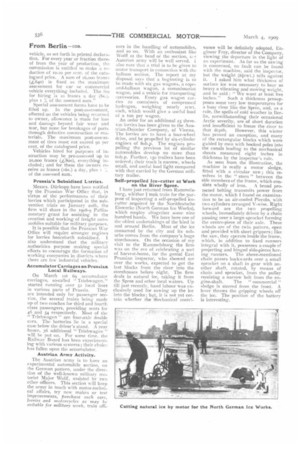From Our Berlin Correspondent,
Page 3

Page 4

If you've noticed an error in this article please click here to report it so we can fix it.
"Subvention" a la Suisse.
Agreeably with an edict issued by the Swiss Federal Council, all selfpropelled vehicles in good condition will be commandeered as a matter of course in time of war, and in time of peace the War Office is entitled to " press " them in return for a compensation determined by a definite system of valuation set forth by the Council.
An Ehrhardt Candidate for Prussian Subvention Plaque.
Messrs, Heinrich Ehrhardt and Co. have now entered the field as candidates for the subvention-plaque, the lorry illustrated here having been constructed on the lines laid down by the War Office. Their lorry, which has been undergoing service trials over heavy and hilly roads, is driven by a four-cylinder motor developing 4oh.p., fed by the firm's carburetter, which works with petrol or benzol very economically, the consumption being about 0.24 and 0.26 kilo, per brake horse-power hour. A cone-clutch transmits power to the differential shaft, the final stage of the transmission taking the chain-and-sprocket form. The front pair of road-wheels are shod with solid rubber tires, but the rear two show the Ehrhardt patent tire. This tire consists of a seamless-rolled steel rim, fitted with cross-grooves, arranged slantwise and filled up with rubber. I understand that, what with the elasticity of the successive vanes and that of the filling, the lorry makes little noise when running.
The Swiss Requisitory and Hiring System.
For furnishing the Swiss army with self-propelled vehicles, the Federal Council, at the instance of the War Office, has established a special system, whereby, agreeably with Article 1, "automobiles, together with equipments and working materials, will be requisitioned for active service according to requiremenls, and also hired for purposes of instruction." The document issued by the Federal Council concerning this matter has been placed at my disposal by the War Office, and a few extracts from its thirty Articles may be of interest. According to Article 3, "the organisation and management of the military automobile affairs are subordinate to the Engineers' Department, which undertakes or conducts the requisite levies and inspections, attends to assignment of men and material, as well as to the control."
The Rolling Stock.
Article 4 declares how requisition is to be made, thus :—" The Chancery of the Federal Department of the Interior is the central office for the keeping of a register of licenses granted by the Cantons. The Engineers' Department receives from the registrar all particulars and remarks entered in regard to the automobiles, owners and chauffeurs, keeps a list of them, and, in conformity with it, on Form I, prepares a control, according to Cantons, of automobiles appearing. suitable for military purposes, which is to be kept up to date."
This so-called Cantonal control comprehends the following particulars, arranged in eleven columns : (I), license number ; (2), name of owner ; (3), address; (4), factory number of chassis and year of manufacture; (5), number of seats (including chauffeur's), or useful load; (6), weight of automobile in kilos. ; (7), horse-power ; (8), number of cylinders; (9), ditnensions of tires ; (so), special observations; (ii), date of inspection, and in what respect useful.
On the basis of these controls, automobiles will be inspected and appraised. Further, the Engineers'
Department has to maintain up-todate registers of firms stocking fitments and working materials.
For the appraisement of vehicles and equipments, a number of guiding principles are set forth in' Article 6, which reads :—"(a), vehicles showing considerable wear and tear of their mechanical parts are to be excluded from assessment; (b), underframe must show a minimum clearance of 20 centimetres (72in.), and the crossbar of the steering contrivance is to be protected by the front axle ; (c), under a full load, the vehicle is expected to climb gradients of at least :5 per cent., and to start on the same ;
(d), every vehicle must have at least two independently-working brakes, each sufficient to stop a fully-loaded automobile descending any rideable gradient, and hold it fast when ascending—a sprag must also be provided to prevent running back ; (e), there must be accommodation for fuel sufficient for at least six hours;
(f), at enrolment, automobiles are, if possible, to possess new rubber tires, or, at any rate, tires in good condition; (g), freight-wagons must be fitted with a packing frame at least 25 centimetres (yin.) high, also a sufficiently-large waterproof cover.
Assessments and Hiring Rates.
Articles 19-25 have to do with the preand post-assessment of vehicles. The Engineers' Department nominates, for each place of assessment, an assessment commission of not less than three members, a proxy and a secretary (the latter not voting).
Articles 23 and 24 describe how vehicles are to be assessed, thus :— " Experts have to make a thorough inspection of the vehicles and give them a practical trial. Assessment is based on maker's price-list, age and condition of chassis, body and tires of
vehicle, as set forth in printed declaration. For every year or fraction there of from the year of production, the commission is entitled to make a reduction of 10-20 per cent, of the cata logued price. A sum of 16,000 francs: (k64o) is fixed as the maximum assessment for car or commercial vehicle everything included. The fee for hiring is io francs a day (Ss.), plus x `),,` of the assessed sum!'
Special assessment forms have to be filled up. In the post-assessment, effected on the vehicles being returned to owner, allowance is made for loss and damage beyond fair wear and tear, but none for breakages of parts through defective construction or materials. The maximum post-assessment of tires must not exceed go per cent, of the catalogued price.
Vehicles hired for purposes of instruction may be pre-assessed up to 20,000 francs (k800), everything ineluded; and for these the owners receive 20 francs (t6s.) a day, plus of the assessed sum.
Prussia's Subsidised Lorries.
Messrs. Dilrkopp have been notified by the Prussian War Office that, in virtue of the performances of their lorries which participated in the subvention trials on January 20th, the firm will share in the 1908-9 Pailiamentary grant for assisting in the creation and working of freight automobiles suitable for military purposes.
It is possible that the Prussian War Office will require stronger engines for lorries henceforth subsidised. I also understand that the military authorities purpose making special efforts to encourage the formation of working companies in districts where there are few industrial vehicles.
Accumulator Carriages on Prussian Local Railways.
On March ist 69 accumulator carriages, so-called " Triebwagen," started running over 52 local lines
in various parts of Prussia. They are intended only for passenger service, the several trains being made up of two coaches for third and fourth class passengers, providing seats for 46 and 54 respectively. Most of the
Triebwagen " are four-axle double cars. The batteries lie in a special case below the driver's stand. .A year hence, 36 additional " Triebwagen " will be put on. For some time, the Railway Board has been experimenting with various systems; their choice has fallen upon the accumulator, Austrian Army Activity.
The Austrian army is to have an experimental automobile section, on the German pattern, under the direction of the well-known military motorist Major Wolff, assisted by two other officers. This section will keep the army in touch with motor-technical affairs, try new makes or test improvements, purchase such cars, lorries and motorcycles as may be suitable for military work, train offi
cers in the handling of automobiles, and so on. With an enthusiast like Wolff at the head of the section, Lie Austrian army will be well served. I also note that a trial is to be given to motor transport in connection with the balloon section. The report at my disposal says that a beginning is to be made with six gas wagons, a ropeand-balloon wagon, a commissariat wagon, and a vehicle for transporting accessories. Every gas wagon carries 20 containers of compressed hydrogen, weighing nearly "cwt. each, which would give a useful load of a ton per wagon.
An order for an additional 25 threeton lorries has been given to the Austrian-Daimler Company, of Vienna. The lorries are to have a four-wheel drive, and be propelled by six-c) limier engines of 8oli.p. The engines propellingthe previous lot of similar automobiles develop no more than 6oh.p. Further, iso trailers have been ordered; their track is narrow, wheels small, and useful load light compared with that carried by the German military trailer.
Sell-propelled Ice-cutter at Work on the River Spree.
I have just returned from Rummelsburg, whither I took train for the purpose of inspecting a self-propelled icecutter acquired by the Norddeutsche Eiswerke (North German Ice Works), which employ altogether some nine hundred hands. We have here one of the oldest undertakings of the kind in and around Berlin. Most of the ice consumed by the city and its suburbs comes from the company's huge storehouses. On the occasion of my visit to the Rummelsburg the firm was on the eve of celebrating a sort of harvest-home, for the genial East Prussian inspector, who showed me over the works, expected to get the last blocks from the river into the storehouses before night. The firm deals in natural ice, taking it from the Spree and other local waters. Up till just recently, hand labour was exclusively used for sawing up the ice into the blocks ; but, it is not yet certain whether the "thechanical contri
vance will be definitely adoeted, Engineer Frey, director of the Company, viewing the departure in the light of an experiment. As far as the sawing is concerned, no fault can be found with the machine, said the inspector, but the weight (newt.) tells against it. I asked him what thickness of surface ice was necessary to bear so heavy a vibrating and moving weight, and he said : " We want at least five
inches." Such a thickness presupposes some very low temperatures for a busy river like the Spree, and, as a rule, the spells of cold weather in Berlin, notwithstanding their occasional Arctic severity, are of short duration and insufficient to freeze the river to
that depth. However, this winter has proved an exception, and many of the rectangular blocks which were guided by men with hooked poles into the canals leading to the mechanical shoots measured eight inches in thickness by the inspector's rule.
As seen from the illustration, the machine is really a motor sledge, fitted with a circular saw; this revolves in the " stern " between the side members of the frame, which con
sists wholly of iron. A broad protected belting transmits power from the motor, which I found on examination to be an air-cooled Piccolo, with two cylinders arranged V-wise. Right forward are the two propelling wheels, immediately driven by a chain passing over a large sprocket forming the centre-piece of their axle. These wheels arc of the twin pattern, open and provided with short grippers; like. the saw, they operate inside the frame, which, in addition to fixed runners integral with it, possesses a couple of projecting and hinged side-pieces having runners. The above-mentioned chain passes backwards over a small sprocket on a shaft in gear with another shaft, rotated, by means of chain and sprocket, from the pulley receiving a narrow belt from the en
gine-shaft. The " commercial " sledge is steered from the front. A lever throws the gripping wheels, off the ice. The position of the battery is interesting.
























